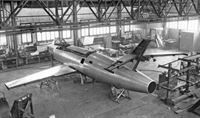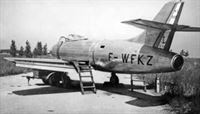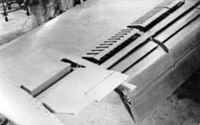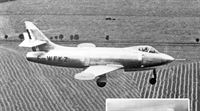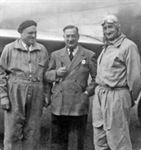Фотографии
-
Регистрационный номер: F-WFKZ [9] Designed to have a short wing to facilitate stowage aboard aircraft carriers (of which France had none at this time), the NC.1080 was fitted with Pierre Lemoigne’s system of slotted flaps and no ailerons. It is seen here on its roll-out at the Aerocentre factory.
Самолёты на фотографии: SNCAC NC.1080 - Франция - 1949
-
Регистрационный номер: F-WFKZ [9] The sole SNCAC NC. 1080, F-WFKZ, in its final configuration at Melun-Villaroche in early 1950, shortly before its demise in April that year. The French were nothing if not ambitious in terms of aeronautical technology in the immediate postwar period, which sadly led to an extremely high attrition rate for test pilots.
Самолёты на фотографии: SNCAC NC.1080 - Франция - 1949
-
Регистрационный номер: F-WFKZ [9], F-WFRD [4], F-ZWRG [4] The NC.1080 in its final configuration at Melun-Villaroche in early 1950, fitted with an extended wing with ailerons (and sans endplates), tall fin, shorter tailpipe and "pig’s ears" on the tailplanes. The sole Nord 2200, parked alongside, is also visible.
Самолёты на фотографии: Nord Nord 2200 - Франция - 1949SNCAC NC.1080 - Франция - 1949
-
Регистрационный номер: F-WFKZ [9] The NC.1080 under construction at the SNCAC (Aerocentre) factory at Issy-les-Moulineaux, still fitted with the original trapezoidal canopy frame and flat-fronted windscreen. A more conventional rounded canopy was fitted, probably before the aircraft was partly dismantled and transported to Toussus-le-Noble.
Самолёты на фотографии: SNCAC NC.1080 - Франция - 1949
-
Регистрационный номер: F-WFKZ [9] Another view of the NC.1080 in its initial configuration, with the original long tailpipe and short fin. The Lemoigne flaps are seen here deployed, and, although the system facilitated the fitting of an excrescence-free wing, it was found to be useless.
Самолёты на фотографии: SNCAC NC.1080 - Франция - 1949
-
Регистрационный номер: F-WFKZ [9] After Lasne’s terrifying first flight in the NC.1080, 50cm (20in)-wide ailerons were fitted to 1m (3ft 3in) wingtip extensions, the port aileron with trim tab being seen here at Bretigny-sur-Orge. The Lemoigne flaps remained as initially fitted.
Самолёты на фотографии: SNCAC NC.1080 - Франция - 1949
-
Регистрационный номер: F-WFKZ [9] The NC.1080 at Melun-Villaroche having undergone several modifications, including the addition of rather brutal wingtip endplates (to palliate spanwise lift migration) and an extension to the fin. After Fernand Lasne’s short hop with the original configuration at Toussus-le-Noble in June 1949, it became evident that the type would need substantial modification.
Самолёты на фотографии: SNCAC NC.1080 - Франция - 1949
-
Регистрационный номер: F-WFKZ [9] Fernand Lasne keeps a cool head in the cockpit of the NC.1080 during its maiden flight on July 29, 1949, despite the fact that he has no lateral control and no radio fitted with which to notify those on the ground. Lasne nevertheless managed to point the aircraft at the CEV airfield at Bretigny-sur-Orge 20km away and land safely.
Самолёты на фотографии: SNCAC NC.1080 - Франция - 1949
-
Регистрационный номер: F-WFKZ [9] From left to right: pilot and Farman engineer Lucien Coupet; NC.1080 designer Charles Pillon and test pilot Fernand Lasne.
Самолёты на фотографии: SNCAC NC.1080 - Франция - 1949
-
The original trapezoidal canopy frame and flat-fronted windscreen, detailed on the original illustration. A more conventional rounded canopy was fitted, probably before the aircraft was partly dismantled and transported to Toussus-le-Noble.
Самолёты на фотографии: SNCAC NC.1080 - Франция - 1949
-
SNCAC NC.1080 (FINAL ITERATION)
Самолёты на фотографии: SNCAC NC.1080 - Франция - 1949
-
Регистрационный номер: F-WFOE [3] The Arsenal VG.90-01, F-WFOE, in its initial configuration at Melun-Villaroche. The VG.90 was a larger development of the same design team’s VG.70 research jet aircraft, which had an unusual air intake scoop arrangement on the underside of the forward fuselage, and which proved to be inefficient. More conventional underwing intakes were incorporated on the VG.90.
Самолёты на фотографии: Arsenal VG-90 - Франция - 1949
-
Регистрационный номер: F-WFOE [3], F-WFRD [4], F-ZWRG [4] The Nord 2200 and the VG.90-01 at Bretigny-sur-Orge in early 1950. The VG.90 has the modified shortened rudder and fairing atop the fin and its new mainwheel doors. The Nord 2200 is still in its first configuration. No armament was fitted to the sole example, and it is not clear where the 30mm cannon would have been located.
Самолёты на фотографии: Arsenal VG-90 - Франция - 1949Nord Nord 2200 - Франция - 1949
-
The second VG.90 in flight, with its undercarriage and flaps extended. After its first flight at Orleans-Bricy in June 1951, the VG.90-02 went to Melun-Villaroche, where Claude Dellys completed 15 test flights in 45 days. Dellys was killed ferrying the aircraft from Melun-Villaroche to Istres on February 21, 1952.
Самолёты на фотографии: Arsenal VG-90 - Франция - 1949
-
Two previously unpublished photographs of the navalisation equipment fitted to the third VG.90. On the left is the wing-folding mechanism and on the right, the ingenious arrester hook device which doubled as a thrust-reversal system. The caught deck-wire pulled the hook rearwards and activated the thrust-reverser plate.
Самолёты на фотографии: Arsenal VG-90 - Франция - 1949
-
The VG.90-02 was coded “M” (its registration appears to be unknown or it may not have been allocated one) and is seen here being prepared for a flight. The production version of the VG.90, designated VG.91, was to be further modified with a revised thinner wing and powered by a Snecma Atar 101C turbojet. The entire project was cancelled, however.
Самолёты на фотографии: Arsenal VG-90 - Франция - 1949
-
Регистрационный номер: F-WFOE [3] Following its first flight, the VG.90-01’s fin was modified several times, first by reducing the height of the rudder, the fin being fitted with a tip fairing, and again, as seen here, with an extended slightly tapered slab section in an attempt to provide more fin and less rudder. The latter was reduced in size again, a 15cm (6in) fillet replacing its lower portion.
Самолёты на фотографии: Arsenal VG-90 - Франция - 1949
-
ARSENAL VG.90-01
Самолёты на фотографии: Arsenal VG-90 - Франция - 1949
-
ARSENAL VG.90-02. The second VG.90 was all-metal, the VG.90-01 having had birch plywood skins on the wings and tailplane. The type sat low to the ground, and the second prototype incorporated a revised undercarriage to avoid the rear fuselage potentially striking the deck when alighting on a carrier.
Самолёты на фотографии: Arsenal VG-90 - Франция - 1949
-
Регистрационный номер: F-WFRD [4], F-ZWRG [4] The Nord 2200 in its penultimate configuration, with the final iteration of the rear fuselage, airbrakes fitted to either side of the aft fuselage, a taller fin with reinstated dorsal fin and lip incorporated into the nose air intake, intended to accommodate the future installation of radar equipment. In 1952 French experimental aircraft registrations were changed from F-Wxxx to F-Zxxx, and the 2200 was accordingly re-registered F-ZWRG.
Самолёты на фотографии: Nord Nord 2200 - Франция - 1949
-
Регистрационный номер: F-WFRD [4], F-ZWRG [4] The 2200 was the 32nd French aircraft prototype to be rolled out in 1949 alone, showing the frantic pace of aeronautical development in the country in the immediate post-war period.
Самолёты на фотографии: Nord Nord 2200 - Франция - 1949
-
NORD 2200 (FINAL ITERATION)
Самолёты на фотографии: Nord Nord 2200 - Франция - 1949
Статьи
- -
- A.Grandolini - The king's Breguets
- C.Richards - British-built Bristol-engined Superforts?
- G.Ellis - Rhodesia's Bush Eagles (2)
- G.Inchbald - Outside edge
- G.Peerless - Hi-de-Hi Flyers!
- J.Mesnard - Trial & terror
- K.Hayward - Airbus Industrie Britain's Return
- L.Hellstrom - The CIA's defection deception
- M.Wickstead - Bringing Africa together (2)
- N.Heap - The Flying Fashionista
- N.Stroud - Goodyear's Terra campaign
- P.Davidson - Off the Beaten Track...
- P.Jarrett - Lost & Found
- P.Stoddard - Sharpening the Scimitar



